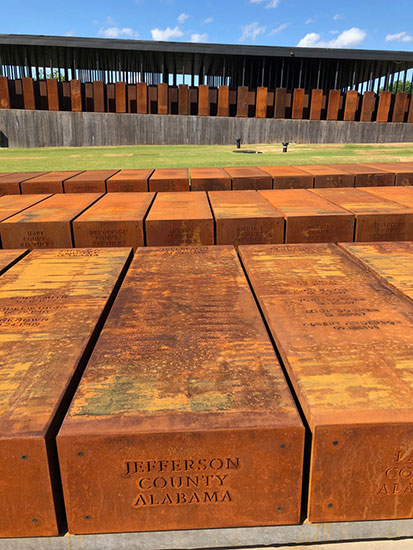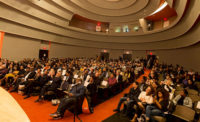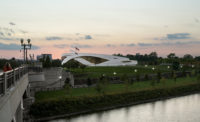On opening day at the Legacy Museum in downtown Montgomery, Ala., visitors were not told to silence their cell phones, but rather to power them off and put them away. “Take in your experience, take in your experience,” one museum staff member said.
He kept repeating the exhortation as throngs of visitors entered the lobby. In a high-ceilinged room with photo displays, wall text, and three video screens, the most compelling visual was a single sentence painted in white on an exposed brick wall: “You are standing on a site where enslaved people were warehoused.”
Such exquisite candor is the most distinctive feature of the new museum, as well as of the nearby National Memorial for Peace and Justice. Both sites opened on Thursday, April 26, 2018, after nearly a decade of work by the Equal Justice Initiative (EJI), a Montgomery-based nonprofit that provides legal representation to indigent defendants and prisoners.
Exhibit design may seem beyond the purview of attorneys, but the interactive displays stand as vivid renderings of EJI research on the history of racial injustice in the United States. The building on Commerce Street is a former warehouse two blocks from a slave auction site: humans were held there before they were sold to other humans. The permanent exhibit is titled “From Enslavement to Mass Incarceration.”
Amid sculpture, photography, and high-tech video projection, one of the marvels inside the museum is a display of dirt—hundreds of pounds of soil, stored in dozens of glass containers on shelves that stand eight feet tall. The shocking showcase looks like a giant spice rack, but instead of cinnamon, pepper, and nutmeg, the clear jars are filled with soil from places like Paris, Texas; Brierfield, Ala.; and Gulfport, Miss. The variety of colors is captivating—some samples look like cocoa, some like mud or Silly Putty. Each mound of dirt was collected by a volunteer who went to the site of a lynching.
According to a report EJI produced in 2015, more than 4,000 African American men, women, and children were killed in lynchings between 1880 and 1940. That number becomes painfully easy to visualize at the National Memorial for Peace and Justice, where their names are emblazoned on 800 columns of Corten weathered steel—one for each U.S. county where a public murder took place.

Photo © Glenny Brock/Architectural Record
Boston-based MASS Design Group partnered with EJI to create the nation’s first national memorial to the victims of lynching. Gravel pathways zigzag across grassy slopes in the six-acre park, sending visitors on a slow walk past rough-hewn concrete walls and a haunting sculpture of an anguished family in chains. As the gradient of the footpath changes, the incline of the walls also change, leaving the visitor with the disoriented feeling of growing taller, then shorter again. The sensation is redoubled by the time you are under the roof from which all the columns hang. As you enter the memorial, you can stand beside the six-foot columns, walk around them and touch them. But as you walk farther, the path slopes downward until the columns loom overhead and you have to crane your neck to read the victims’ names. In a vast passage with timber walls, there are placards with individual lynchings narrated in single sentences and a stone wall with a dedication that reads, in part, “We will remember.”

Beyond the sheltered structure is an expanse of grass that resembles a burial ground; laid out in rows are duplicates of all 800 hanging columns. They look like flat, rusty caskets, the patina of each in brilliant contrast to the green lawn beneath it. The idea, according to EJI founder Bryan Stevenson, is that counties all over the U.S. will claim the monuments, removing them from the Montgomery memorial and installing them in the locations named.
The inclines bring to mind the Vietnam Veterans Memorial in Washington; the layout of the memorial columns evoke the Holocaust Memorial in Berlin. But the honest materials at the National Memorial—weathered steel and American hardwoods—confer a singular power on the place.
According to Sherrilyn Ifill, president and director-counsel of the NAACP Legal Defense Fund, it’s a site of psychic excavation. “You’re unearthing a history that was covered over and buried,” Ifill said. “We have to take the dirt off of it and be brave enough to look at it.”
















Post a comment to this article
Report Abusive Comment